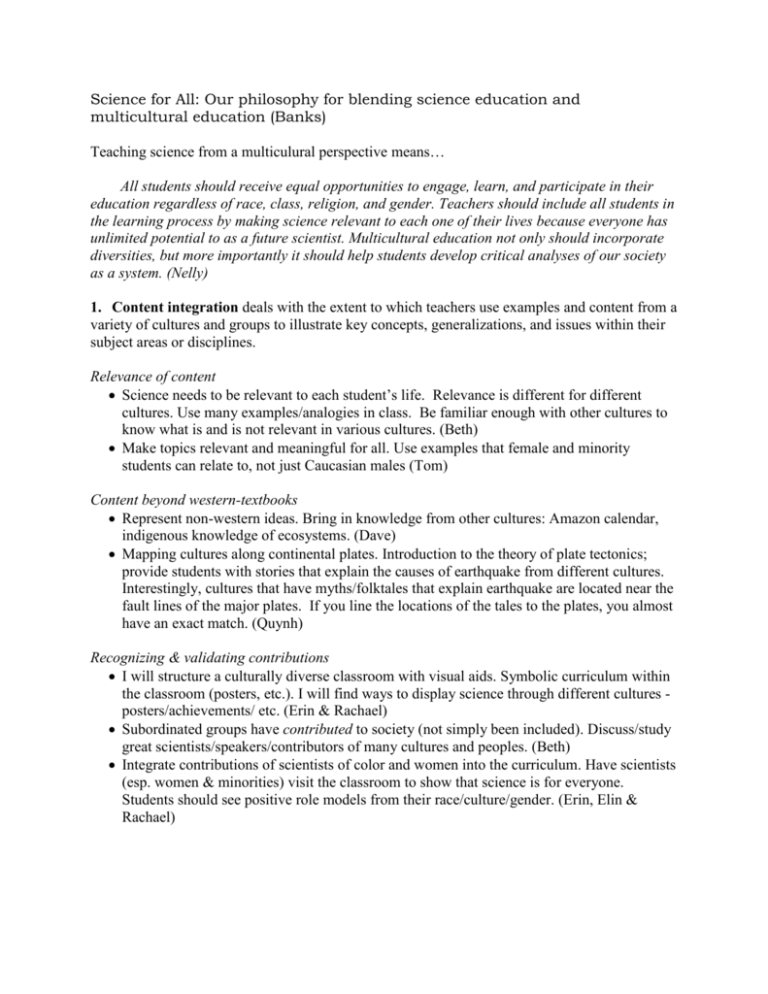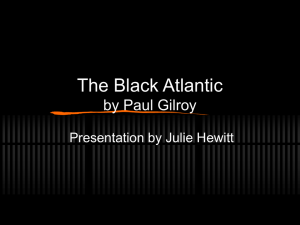Multicultural Teaching Philosophy
advertisement

Science for All: Our philosophy for blending science education and multicultural education (Banks) Teaching science from a multiculural perspective means… All students should receive equal opportunities to engage, learn, and participate in their education regardless of race, class, religion, and gender. Teachers should include all students in the learning process by making science relevant to each one of their lives because everyone has unlimited potential to as a future scientist. Multicultural education not only should incorporate diversities, but more importantly it should help students develop critical analyses of our society as a system. (Nelly) 1. Content integration deals with the extent to which teachers use examples and content from a variety of cultures and groups to illustrate key concepts, generalizations, and issues within their subject areas or disciplines. Relevance of content Science needs to be relevant to each student’s life. Relevance is different for different cultures. Use many examples/analogies in class. Be familiar enough with other cultures to know what is and is not relevant in various cultures. (Beth) Make topics relevant and meaningful for all. Use examples that female and minority students can relate to, not just Caucasian males (Tom) Content beyond western-textbooks Represent non-western ideas. Bring in knowledge from other cultures: Amazon calendar, indigenous knowledge of ecosystems. (Dave) Mapping cultures along continental plates. Introduction to the theory of plate tectonics; provide students with stories that explain the causes of earthquake from different cultures. Interestingly, cultures that have myths/folktales that explain earthquake are located near the fault lines of the major plates. If you line the locations of the tales to the plates, you almost have an exact match. (Quynh) Recognizing & validating contributions I will structure a culturally diverse classroom with visual aids. Symbolic curriculum within the classroom (posters, etc.). I will find ways to display science through different cultures posters/achievements/ etc. (Erin & Rachael) Subordinated groups have contributed to society (not simply been included). Discuss/study great scientists/speakers/contributors of many cultures and peoples. (Beth) Integrate contributions of scientists of color and women into the curriculum. Have scientists (esp. women & minorities) visit the classroom to show that science is for everyone. Students should see positive role models from their race/culture/gender. (Erin, Elin & Rachael) 2. The knowledge construction process describes how teachers help students to understand, investigate, and determine how the biases, frames of reference, and perspectives within a discipline influence the ways in which knowledge is constructed within it (Banks, 1996). Students also learn how to build knowledge themselves in this dimension. Critical view of knowledge construction in science Science is not totally objective. Teach about ways science is not always objective. (ex. what gets studied/funded, historical aspects (eugenics), which results are reported and which are not, how to read science in the news with a critical eye, etc.) (Beth) Social justice should be a part of the science classroom. Be open about scientific racism (bell curve) & stress that biological race does not exist. (Dave) Students should address political/social issues behind current event topics. Students will debate a current "hot topic" event. (Rachael) Keep science 'REAL'- Bring the lives of scientists into focus for the students in order for the students to realize that the scientists are human and similar to them. (Tom) Knowledge construction for students I want to bring their lives to science and for them to see its importance there. Active reflections of how science makes a difference in their lives and society. (Rachael) I would bring students' lives to science by finding things in their world that they may not know are already a part of science. (Elin) Language differences are recognized and respected. Use student vocabulary - have them explain things their own way. -I would use media, pop culture, and technology to help relate the students to scientific ideas and principles (Rachael) Try to not "lose" students- Have students discover the language of science and define this language using their own terms. (Tom) I will understand that not everyone comes from the same place. I will try to "get" where they are coming from. Open class with asking students questions to get a feel of where they are coming from. (Rachael) 3. Prejudice reduction describes lessons and activities used by teachers to help students to develop positive attitudes toward different racial, ethnic, and cultural groups. Research indicates that children come to school with many negative attitudes toward and misconceptions about different racial and ethnic groups (Phinney & Rotheram, 1987). Research also indicates that lessons, units, and teaching materials that include content about different racial and ethnic groups can help students to develop more positive intergroup attitudes if certain conditions exist in the teaching situation (Banks, 1995b). These conditions include positive images of the ethnic groups in the materials and the use of multiethnic materials in a consistent and sequential way. Multicultural education can be part of science on a regular basis. Types of activities, content, attitudes, and classroom atmosphere can be examined to make sure they benefit all students everyday. (Beth) ALL students need to learn/practice equity and diversity, even homogeneous classrooms. Use MCE is all classes and all schools regardless of degree of racial/cultural/gender/socioeconomic etc. differences. (Beth) Bring in guest scientists from different cultures and backgrounds either in person or through articles (Tom). Know each student. Have students write letters of themselves or index cards/signs that talks about themselves. (Nelly) Modify strategies to facilitate the achievement of all students. Have students express their ideas however they want - visual/spoken/written. Vary assessment and teaching styles so that all students have equal chance for achievement Involve visual, hands-on activities, writing and speaking exercises (Erin & Rachael) 4. An equity pedagogy exists when teachers modify their teaching in ways that will facilitate the academic achievement of students from diverse racial, cultural, and social-class groups (Banks & Banks, 1995). Research indicates that the academic achievement of African American and Mexican American students is increased when cooperative teaching activities and strategies, rather than competitive ones, are used in instruction (Aronson & Gonzalez, 1988). Cooperative learning activities also help all students, including middle-class White students, to develop more positive racial attitudes. However, to attain these positive outcomes, cooperative learning activities must have several important characteristics (Allport, 1954). The students from different racial and ethnic groups must feel that they have equal status in intergroup interactions, teachers and administrators must value and support cross-racial interactions, and students from different racial groups must work together in teams to pursue common goals. Students of different cultures may learn best in other ways. Use many different learning styles frequently. (ex. collaboration, audio/visual/written, hands-on, dramatic, etc.) For example, give students a choice of how to present a project or group activity. Teach using multiple approaches. (Beth & Tom) Regularly assign group work - all members participate and share responsibility for each others' learning and for the completion of the assignment (Erin) I would make sure that I have scientific relationships that will connect diverse student populations to the scientific ideas. I would use examples that are central to all students' lives, not just the white, middle class, male students. (Elin) I would make sure students have equal access to the curriculum by scheduling computer lab time if they don't have computers at home, and I would allow students to come into the classroom to use books and other materials before school, after school and during lunch. (Erin) 5. An empowering school culture and social structure is created when the culture and organization of the school are transformed in ways that enable students from diverse racial, ethnic, and gender groups to experience equality and equal status. The implementation of this dimension requires that the total environment of the school be reformed, including the attitudes, beliefs, and action of teachers and administrators, the curriculum and course of study, assessment and testing procedures, and the styles and strategies used by teachers. Teacher reflection I (the teacher) need to constantly recognize and reevaluate my biases, privileges and power. Continually check my attitudes/behaviors to make sure they are equitable and fair. As a teacher, be diligent about building community within the classroom! (Beth & Erin) Teachers must have high expectations for all students and not reinforce norms & stereotypes. Let students know that I believe in everyone and that all students are capable. (Dave) Reflect on my practice. Be conscious not to make assumptions. Ask: Who am I calling on? (Dave) Multicultural education should be in every aspect of school, not just my classroom. Discuss with other faculty what has worked in my classroom. Encourage them to try some MCE strategies. Provide support for them. (Beth) Teacher actions Read about cultures that students are from and connect with parents. (Dave) I would balance what I know about science with what I know about each student. Both are very important. (Elin) Keep students involved- Take action on a relevant social issue, Foster a safe, sharing classroom that encourages participation from all students. Try to get feedback from all through interactions, writing, etc. (Tom) Students need to take social/political action to be empowered. Example: writing letters, using information learned in class, to local agencies regarding environmental issues in the community - pollution, etc. (Quynh)








